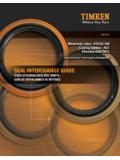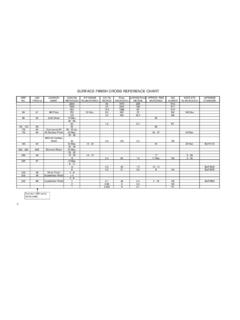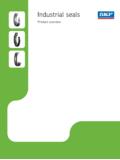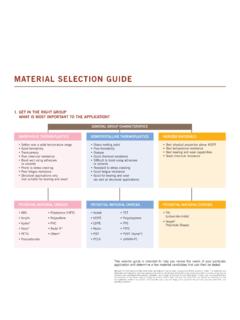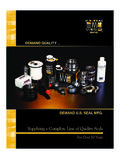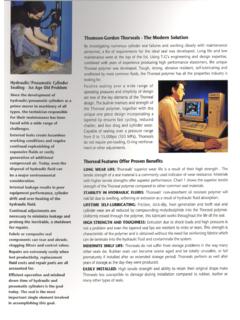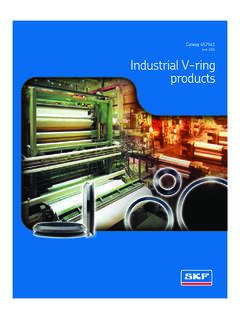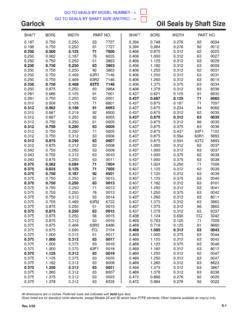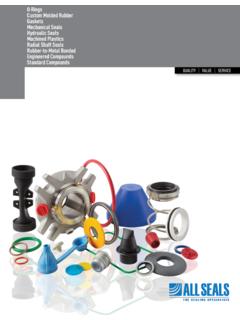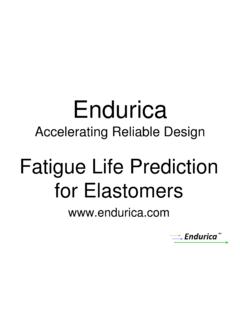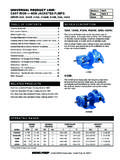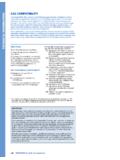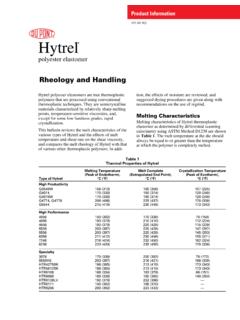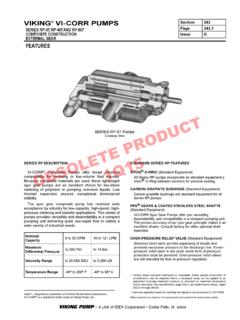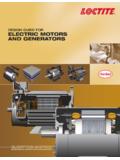Transcription of Sec 4 Designing Plastic - All Seals Inc.
1 4-1 Section 4 Designing PlasticComponents plastics Technologies and Services .. Assemblies .. Plastic Design Issues .. Shrinkage .. Wall Thickness .. Corners .. Holes .. Knit Marks .. Undercuts .. Taper .. Threads .. Total Indicator Reading .. Warpage .. Surface Finish .. Color Coding .. Inserts .. Secondary Operations .. Plastic Over-Molding .. Writing Your Plastic Component Specifications ..4-94-74-74-74-64-64-64-64-64-54-54-54- 44-44-34-24-24-24-2 Copyrights 2003 Minnesota Rubber and QMR plastics . All rights experience in applications for high performance materialsand thermoplastic elastomers allows us to view a new designor re-design criteria objectively.
2 As the components we produce are typically part of a larger assembly many cus-tomers have benefited from our part consolidation recom-mendations that allow us to design, develop, manufacture,test, package and ship their completed assembly. In order to meet critical time-to-market requirements weprovide creative solutions for assembly programs. Whether it is a simple two component sub-assembly or a complex,multi-component rubber and Plastic assembly that incorporates inserts, and hotplate welding, we offer cost-effective engineered s more, we know how to maintain the integrity of yourbasic design while taking into consideration factors such asshrink distortion and parting lines.
3 This helps avoid surpriseswhen it comes time to manufacture, assemble and use theend the relationship between materials, parts and end-use performance need to be addressed, we also know how tosolve problems arising from torque values and sealing contacts. We then ensure that the rubber and Plastic materials complement each other s tolerance the design is complete, we can follow through withtesting through the use of tools, such as FEA, where benefitssuch as increased strength, reduced material use and reducedcosts can be realized. Plastic Design IssuesInjection molded Plastic parts offer an important combinationof flexibility, toughness, and chemical resistance for costeffective, long-term performance in a wide range of applications.
4 However, not every Plastic part design can be efficiently injection molded. So working with us early in the design process is important. With our experience inplastics materials and molding, we can help you design parts that are both functional and within materials are heated in the barrel and injectedinto the mold cavity. As the part cools in the mold, it cross-section areas cool at a substantially lower ratethan thin cross-sections, and press cycle time is based on the cooling rate of the thickest , even one relatively thick cross-section area willincrease the press cycle time, thereby reducing the numberof parts per hour and increasing the cost per PlasticComponentsPlastics Technologies and ServicesQMR plastics offers a wide range of technical services and production capabilities for producing close tolerance components.
5 Our specialty processes and services include: Hotplate, rotational and ultrasonic welding Adhesive bonding, hot stamping and machining Bonding for Plastic to metal, Plastic to rubber and Plastic to plasticCorrectIncorrectDistortionand Sink4-3 The uneven rate of cooling of these thick and thin cross-sections is also likely to result in distortion of the part after it has been removed from the mold. This distortion is often severe enough to prevent the part from meeting thick cross-section is also likely to result in a depression on the surface called a sink mark,particularly if the cross-section is of varying good rule of thumb is to design all part cross-sections as thinly and uniformly as possible.
6 The use of ribs is an effective way of achieving rigidity andstrength while avoiding cross-sectional cases where it is impossible to avoid a thick cross-section, ribs may also help to minimize the distortion that can occur during post-cure. Very complex shapes that must combine thick and thin cross-section should be reviewed in advance so as to determine dimensional stability and tolerance changes that will occur during and after ThicknessUniform wall thickness is critical in part design for an injection molded part. Non-uniform wall thickness causes dimensional control problems, warpage and other part integrity techniques on thin walls become quite complicated.
7 For efficient, high volume production,we recommend a minimum wall thickness of . (. )on small parts, . ( )on larger PINPARTING LINEC ornersTwo key points to keep in mind when Designing part corners:the mold is machined from steel, and it s easier to machine aradius than a square , whenever possible, when viewed from the top,the part should display round corners. When seen from theside, the edges should be hole or is created in a part by inserting a core pin inthe cavity. Holes at a right angle to the mold parting line arerelatively easy to produce since the core pin is parallel to theinjection path.
8 The normal shrinkage process, however, cancause the part to cling to the core as it cools in the mold. Inorder to facilitate ejection of the part from the mold, a draftshould be incorporated along the length of the , due to the flow characteristics of the molten materialduring the molding process, square corners tend to be weakerthan rounded corners. To ensure dimensional stability, werecommend a minimum radius of .010 (.254mm).Holes that are parallel to the mold parting line call for theuse of a sliding core that automatically retracts from the partas the mold opens. The use of sliding cores adds to the costand complexity of tool design and construction.
9 If a hole does pass completely through a part, or if the part contains holes on more than one side, the mold must bedesigned to hold the part on a specific side of the open moldto facilitate automatic parts PIN4-5 PreferredAlternateLeast PreferredLong, fragile cores tend to warp or break under continuous use due to the heat and pressure of their operating environment. The size of the core pin, and thus the diameter of the hole, should therefore be maximizedwhenever possible, particularly at the base, to ensure the stability of the pin. A useful rule of thumb to rememberwhen Designing part holes is the rule : The height of the hole should not be more than twice its MarksA core pin blocks the normal path of the molten material as it enters the mold.
10 A weak point called a knit mark can be created on the back side of the pin where the materialflows together. These weak points can be eliminated byproper placement of the gate, or material entry point. It istherefore critical that you call out areas where knit markscannot be tolerated so that potential problems can be eliminated in the mold design MARKSU ndercutsThe ease with which a Plastic part is removed from the mold is determined in large part by the presence and depthof undercuts, the cross-section thickness, and the flexibility of the thermoplastic material . The undercut must be shallowor the material must have considerable give in order toallow the core pin to be snapped from the molded featuring an undercut on the are often molded by a split-shell process.

